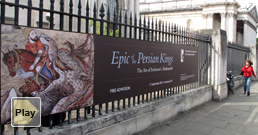The Art of Shahnameh
30.9.2010
Lucinda H. Dunn
When Abu’l-Qasim Ferdowsi finally completed the Shahnameh in 1010, after thirty years of toil, and presented it to Sultan Mahmud of Ghazna it is said the Emperor initially failed to appreciate its value. But the legendary epic poem, dramatising the tales of Persian dynasties up to the Arab invasion in the 7th century, immediately gained a life of its own.This year marks a thousand years since its completion, and still today the manuscript is cherished by all Iranian peoples as an embodiment of their true national identity.
But according to scholar and curator Dr Barbara Brend, it is important to the rest of the world as well: “It is a very great work of literature in what you might call the ‘world class’, so of course it is important to Persians, the people of Iran, but it means it is worthwhile the rest of us getting to know [it] as well.”
One external devotee of the work of art is Charles Melville, Professor of Persian History at University of Cambridge, who has for ten years been building the website Shahnama Project, dedicated to its study. It is thanks to him that this anniversary will not go unnoticed.
In the most ambitious exhibition yet mounted in the UK, Epic of the Persian Kings: The Art of Ferdowsi’s Shahnameh, nearly 100 paintings from exquisitely illustrated manuscripts spanning a period of 800 years are on display at the Fitzwilliam Museum in Cambridge, from 11 September to 9 January 2011.
Professor Melville conceived the exhibition, providing translation of stories and interpretation of the illustrated scenes, and curator Dr Barbara Brend secured this extensive collection for public display.
Shahnameh’s heroic stories tell of the rise and fall of subsequent Persian Kings and heroes, and ongoing wars waged amongst rivals. Interwoven in these stories are ethical messages about justice in kingship and the ordering of society.
These illustrated manuscripts bring little-known Persian myths to an outside audience. We learn about our legendary hero Rostam, his exploits, triumphs and final annihilation by his evil brother Shaghad, who he manages to spear before dying himself. We see the night he meets Princess Tamineh, who boldly asks to bear his child. Dramatically, Rostam only discovers Sohrab is his son immediately after slaying him in battle.
With the collection made up of pictorial versions taken from distinct periods in Iranian imperial history, you get a real sense of how the stories were passed down and treasured over several generations. Visual interpretations also differ. For example, during the rule of the Mongols these 14th century illustrations become larger and more abundant; the Chinese and Arabic influences are evident in the orientally-slanted eyes, and the style of clouds.
Also fascinating are Ferdowsi’s subtle messages around the religious history of Iran. He depicts the new King Lohrasp being enthroned at court. It is Lohrasp’s son who would introduce Zoroastrianism to Persia. Elsewhere we see historical figure, Rostam Farrokhzad, receiving the envoy of Sa’ad Waqqas, bringing the message that the Persians should submit to Islam. Rostam, who was chosen by the Sassanian King Yazdegerd III to lead the Persian army, rejects this proposition, but is then defeated in the battle of Qadesiyeh.
Ferdowsi himself does not refute Islam but continuously makes the distinction between the Persians and the Arabs.
In another striking image, ‘The ship of Shi’ism’, which was created in the Safavid period, shows a boat containing Mohammad, Ali and the Imams steering the dark waters. This one image powerfully captures the unique and complex religious path chartered by the Iranians in their history.
And of course, he famously wrote the entire epic in new Persian, painstakingly avoiding the use of Arabic words where possible.
Ultimately, the purpose of the Shahnameh was to preserve and remind Iranians of their own culture and identity after the dual conquest of the Arabs and Islam. And for this reason it reaches far beyond its literary form.
As well as the illustrated manuscript leaves, other exhibition sections give a sense of how deeply the stories penetrated everyday life. Objects on display include bowls and ceramic tabletops painted with re-enactments of the stories and their morals. These characters live on independently in the national imagination.
The exhibition is an opportunity for British visitors with little or no exposure to Persian culture to bathe in a deeper part of the nation’s character. But also, for those second generation Iranians who have grown up outside of Iran, to learn about their own culture and bridge that gap in their imagination.
Nessa Aziz, 28, now a secondary school teacher in Hackney, moved from Iran to the UK when she was three years old. She says: “This exhibition is necessary for those Iranians living outside of Iran; I really hope they all come and see it.”


